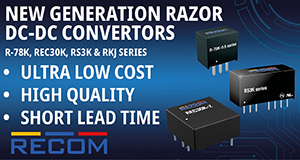A Lawrence Berkeley National Laboratory report in 2016, states that data centers across the United States consumed a whopping 70 billion kWh of energy in 2014. It comes as no surprise that the industry is continuously looking for ways to increase power efficiency and density. Higher efficiency saves both electrical and major operational expenses such as cooling. It also enables operators to increase rack density and available computing space and to meet increasing demands more cost-effectively.
The advent of wide-bandgap devices such as gallium nitride (GaN) is enabling a new generation of power conversion designs not previously possible with silicon metal-oxide-semiconductor-field-effect-transistors (MOSFETs). These designs enable systems to reach new levels of power density and efficiency. GaN-based solutions can be incorporated into power supplies throughout data centers, from the AC mains to the individual points of load (POLs). GaN also enables new architectures such as high-voltage DC distribution systems.

Electric utilities require a power-factor-correction (PFC) stage in order to optimize power grid efficiency. PFC operates as a boost converter and typically provides a DC output voltage of 380V. This voltage needs to be further stepped down to provide a DC bus supply for the system. Various topologies are used for this stage, but inductor-inductor-capacitor (LLC) and phase-shifted full bridge are commonly used to generate a bus voltage of 12V or 48V. This bus voltage is routed throughout the system and undergoes multiple conversion steps to power various POLs such as processors, field-programmable gate arrays (FPGAs), memory and storage.
GaN-based solutions, shown in Figure 2, fundamentally change both the architecture and density of the entire power system, from the AC to the processors. Let’s break it down.
- PFC: By enabling a totem-pole topology, GaN devices such as the integrated Texas InstrumentsLMG3410 reduce the number of active power switches and filter inductors by 50%. A four- to tenfold increase in switching frequency (continuous conduction mode [CCM] or critical conduction mode [CRM] operation) significantly reduces the size of magnetics while improving overall efficiency to over 99%, versus 96% for today’s titanium-grade power supplies. Interleaved solutions further enable designers to scale the power stage to meet system demand.
- LLC: The DC/DC stage takes advantage of GaN’s superior switching characteristics to push the resonant converter to over 1MHz. The high frequency reduces the magnetics while improving power density and efficiency. The smaller form factor further enables the emerging high-voltage distribution systems in data centers for 380V-to-48V converters.
- POL DC/DC: GaN has a major impact on these converters. First, it enables a single step conversion from 48V in order to power processors, memories and other loads directly, reducing component counts on precious printed circuit board (PCB) real estate by as much as 50% while reducing footprints by 75%. Second, the half-bridge current double topologies using theLMG5200 enable designers to easily stack the power stages for different load demands and placed closely to the load for best transient performance.
The days of GaN being viewed as a future technology are over. GaN is here now and is enabling designers to do what was once unreachable: design new power systems that are substantially smaller, switch faster and are cooler than ever before.
See a live demonstration of a TI GaN-enabled AC-to-processor power solution in TI’s booth (No. 701) at the Applied Power Electronics Conference (APEC), March 26-30 in Tampa, Florida. Follow TI at www.ti.com/apec2017.







